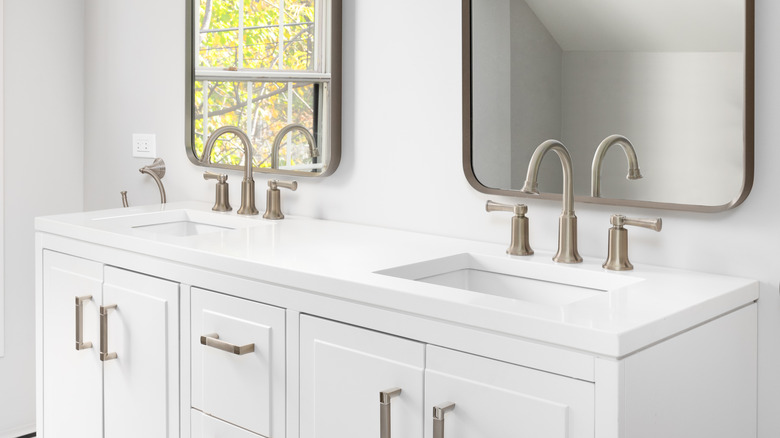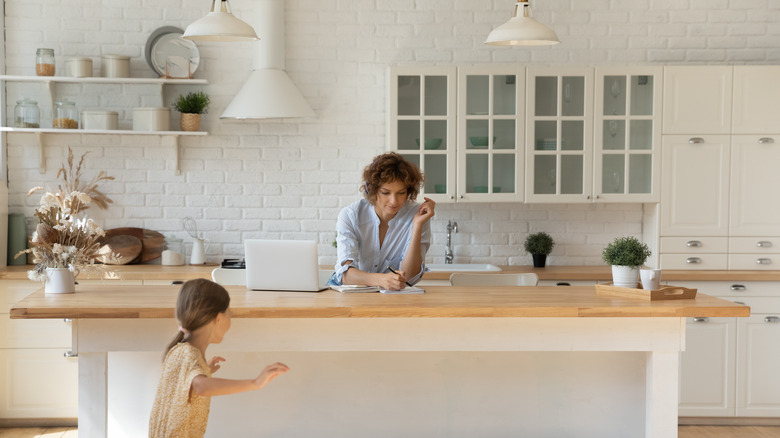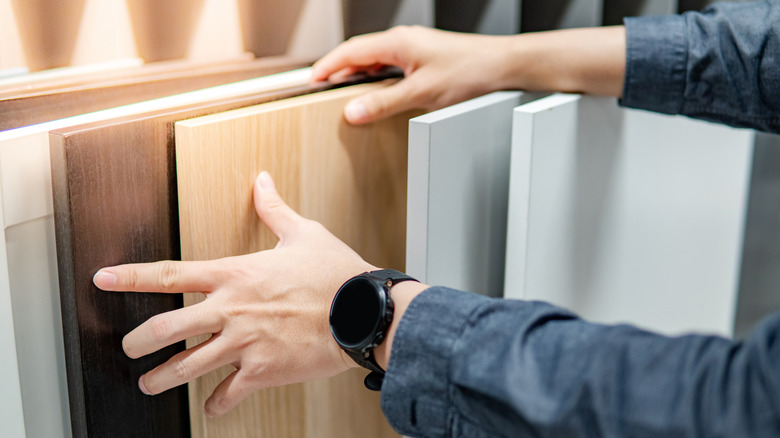What Is An Eased Edge On A Countertop?
Choosing a countertop material is just the start of all the decisions you need to make in a kitchen or bathroom renovation. You have to carefully consider questions like "Are waterfall countertops just a fad?" or "Is that patina-aged bathroom mirror easy-clean enough?" Minute details — for example, countertop edging — can have outsized impacts on the overall design. Of all the edge options, one you're likely to see pop up often is the eased edge. It's square but with the sharp edges rounded off just slightly. In fact, this detail is sometimes referred to as a "softened square" or "round over" edge. It's about as square as you can get a countertop without creating something so sharp it might tear the microfiber cloth you use to clean it.
Eased edges are used on both bathroom and kitchen countertops. Their defining feature is a straight, square edge rounded off for safety and practicality. Don't confuse the eased-edge style with the pencil-edge design. While they may look similar at first glance, the eased-edge countertop has one-eighth of an inch removed from the corners, creating a sometimes severe 90-degree angle. By contrast, the top of a pencil-edge countertop is rounded to a quarter of an inch and the bottom to one-sixteenth. It has a slightly softer look and feel. The eased edge has been trending in recent years because, while it has crisp lines and a fresh feel, it falls short — in a good way — of cutting edge.
It's (almost) all good
If you're wondering what type of countertop edge is best for a modern kitchen frequented by kids, wonder no more. The corners are subtly rounded off on an eased edge slab, resulting in fewer forehead knicks. It's also an easy-clean option since there's no dirt-collecting detailing. An eased edge is also budget-friendly — in fact, it's typically the cheapest edge your money can buy. It's often the default detailing for stone slab manufacturers and sellers, so you might even get it (the edge, not the slab) for free.
Interior designers love eased edges because they're arguably the easiest to work with. They fit squarely into corners and up against other features and take nothing away space-wise from the countertop surface, making them the perfect option for diminutive kitchens and bathrooms. You can use it with almost any material — natural stone like marble and granite, porcelain, laminate (it hides the tell-tale layering), and even wood. The soft square edge looks "thick," allowing the homeowner to show off a particularly nice slab of stone, but it's subtle enough that it doesn't overshadow statement features, fixtures, or appliances. "Simple edge details are still the most popular," notes Ed Rogers, Executive Vice-President of Vadara Quartz, via Kitchen & Bath Design News. "Eased edges are elegant and go with really any kitchen design." In fact, an eased edge is the go-to option for interior designer and style expert Amanda Katherine: "95% of the time, it's what we recommend for clients."
Invest in an eased edge
The eased edge earns its fair share of pointed criticism. The style is, well, basic and often overused. Some also argue that an eased edge countertop is more prone to chipping, cracking, and causing injury. Still, the complaints pale in comparison to the praise. If you want to buy an eased edge countertop, first consider what proportion of your full kitchen remodel budget you want to spend. Since most materials come with an eased edge option, price will dictate your decision.
An 8-foot marble-look laminate countertop with an eased edge and integrated backsplash goes for $184.00 at Home Depot. Jerong Products in California sells a 3-centimeter-thick eased-edge black granite slab (49 by 22 inches) vanity top for $345.00. Head to Wayfair for an unfinished acacia wood butcher block countertop (6-foot long by 25-inch wide by 1.5-inch thick) with an eased edge — $135.30 on sale. If you're handy with an angle grinder, you can try to DIY an eased angle on unfinished countertop slabs or blocks, saving you some money and turning your countertops into a unique home feature.
Eased-edge countertops are generally easy to care for. In addition to following general care instructions for the countertop material provided by your interior designer or the countertop manufacturer or supplier, you should make sure you don't sit weighty or fresh-out-of-the-oven cookware or dishes too close to the edge, or you'll risk cracking or chipping—this is especially true of natural stone tops.


